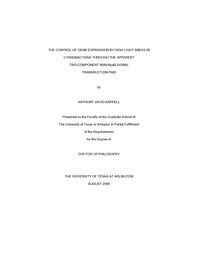
ATTENTION: The works hosted here are being migrated to a new repository that will consolidate resources, improve discoverability, and better show UTA's research impact on the global community. We will update authors as the migration progresses. Please see MavMatrix for more information.
Show simple item record
| dc.contributor.author | Kappell, Anthony David | en_US |
| dc.date.accessioned | 2008-09-17T23:35:08Z | |
| dc.date.available | 2008-09-17T23:35:08Z | |
| dc.date.issued | 2008-09-17T23:35:08Z | |
| dc.date.submitted | July 2008 | en_US |
| dc.identifier.other | DISS-2216 | en_US |
| dc.identifier.uri | http://hdl.handle.net/10106/1102 | |
| dc.description.abstract | In nature photosynthetic organisms including cyanobacteria are dependent upon their
ability to acclimate to changes in environmental conditions including light and nutrient levels. The
NblS sensor kinase of the cyanobacterium Synechococcus elongatus PCC 7942 regulates gene
expression in response to a number of stress conditions including high-intensity light and nutrient
limitation. NblS is known as DspA or Hik33 in the cyanobacterium Synechocystis PCC 6803. We
determined that the high light-inducible hliA gene from S. elongatus is under negative control
through NblS. We have identified the High Light Regulatory 1 (HLR1) sequence (two direct
repeats of (G/T)TTACA(T/A)(T/A) separated by two nucleotides) upstream of a number of genes
in S. elongatus and Synechocystis known to be regulated through NblS and DspA, including the
high light-inducible hli genes, and found the HLR1 sequence is conserved upstream of hli genes
in many other cyanobacteria, the Cyanophora cyanelle, and cyanophage. We have identified the
response regulator RpaB as the factor that binds the HLR1 sequence upstream of high light-regulated genes in S. elongatus and Synechocystis specifically the hliB and hliC genes from
Synechocystis and hliA and psbAI genes from S. elongatus. In response to nutrient limiting
conditions, the S. elongatus nblA gene is known to be regulated through NblS. We have found
this control to be negative, with NblS repressing nblA expression under nutrient replete
conditions, a repression which is relieved during nutrient limitation. We have shown that RpaB
binds an HLR1 sequence found overlapping the promoters predicted from the two main
transcriptional start sites of nblA, as well as binding the HLR1 site overlapping the predicted
promoter of hliA, consistent with RpaB also acting as a negative regulator of these genes, as
NblS is. A separate response regulator, NblR, is known to positively regulate nblA. We have
found that the NblR response regulator is under redox control and binds upstream of nblA at a
site containing two indirect repeats of (T/C)CT(C/G)AGAAAGG separated by six nucleotides
(termed the reduced NblR binding (RNB1) element). Since nblA appears to be under positive
control through the response regulator NblR binding to the upstream region, but under negative
control through NblS, and apparently RpaB, and hliA is regulated by NblS and RpaB, but not
NblR, NblS and NblR are not likely to form a direct cognate response regulatory pair. We
hypothesize that NblS and RpaB do form a cognate two-component regulatory pair. In this work
we present a model for gene control by NblS-RpaB and discuss the possible overlapping
regulation of nblA by RpaB and NblR. | en_US |
| dc.description.sponsorship | van Waasbergen, Lorraine | en_US |
| dc.language.iso | EN | en_US |
| dc.publisher | Biology | en_US |
| dc.title | The Control Of Gene Expression By High Light Stress In Cyanobacteria Through The Apparent Two-component NblS-RpaB Signal Transduction Pair | en_US |
| dc.type | Ph.D. | en_US |
| dc.contributor.committeeChair | van Waasbergen, Lorraine | en_US |
| dc.degree.department | Biology | en_US |
| dc.degree.discipline | Biology | en_US |
| dc.degree.grantor | University of Texas at Arlington | en_US |
| dc.degree.level | doctoral | en_US |
| dc.degree.name | Ph.D. | en_US |
Files in this item
- Name:
- umi-uta-2216.pdf
- Size:
- 3.882Mb
- Format:
- PDF
This item appears in the following Collection(s)
Show simple item record


